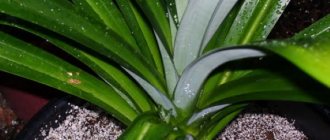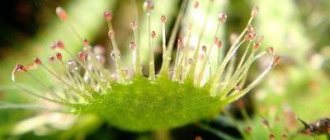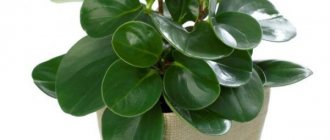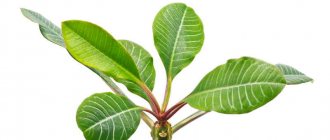Lithops are succulents belonging to the family Aisaceae, or mesembryanthemum. These amazing plants look like pebbles, which is why they are called “living stones.”
Exotic plants are dwarfs. Their height does not exceed three to four centimeters.
The body of “living stones” is formed by paired fleshy leaves that grow together at the base. The stem is missing. The color of plants can vary greatly depending on the color of the soil. It can be green, yellow, gray, brown, brown, beige, pink, red, purple, blue. The unique leaves of Lithops (convex or flat) are covered with various patterns. Every spring, old leaves are replaced with new ones.
The flowers of these original representatives of the plant world resemble chamomile in appearance. They are quite large (2–4 centimeters in diameter) and exceed the size of the succulent itself. The buds are laid in late summer or autumn. Flowering lasts about 10 days. The buds close at night and open in the afternoon. Exotics bloom annually, but only after reaching 3–4 years of age. Able to live 15–18 years.
Please note that “living stones” contain toxins. Therefore, you need to keep them out of the reach of small children.
There are 37 known species of Lithops, which, due to their tendency to modification, can only be classified by specialists.
The following species are most often grown indoors:
- Beautiful. Brown-yellow leaves reach 3 centimeters in length. White flowers emit a light, pleasant aroma.
- Divided. Green leaves (their length is 1–3 centimeters) are covered with gray-green spots. The flowers are yellow.
- Soleros. The length of the leaves is 2–2.5 centimeters. The side part is painted gray, and the top part is olive green and has dark spots.
- False truncated. The leaves are brownish or grayish, and may have a pinkish tint. The top surface is covered with dots or lines. The length of the leaves is 1–3 centimeters. The flowers are bright yellow.
5% discount with promo code SR5!
Especially for our blog readers.
Bloom
Lithops are interesting plants that come from the genus of succulents and belong to the Aizov family. They do not have a stem and in appearance resemble small stones, round in shape and of various colors.
Succulents have fleshy, thick leaves that are paired together and separated by a deep hollow. The maximum height can reach up to 10 cm.
When does lithops bloom at home? The plant begins to bloom only in the third year after planting , from late summer to November. Only some individuals bloom, and the rest join gradually every year. An inflorescence appears between the leaves, usually yellow or white flowers. And the bud opens for several hours a day and can cover the entire succulent. The flowers have a large number of sepals and petals.
The buds last 7–12 days. In the case of pollination, a seed box appears at the end of flowering.
Important! Lithops require rest for normal functioning. During hibernation, the process of molting occurs - the replacement of old leaves with new ones. At this time, it is necessary to completely stop watering and place the pot with the plant in a cool, bright place and leave it alone.
The optimal temperature is considered to be 12–16 degrees. Shedding stops in March–April. Only mature succulents require this care. Young seedlings up to a year old need constant watering and additional lighting.
General information
The plant is a perennial succulent. Its root system is very developed and exceeds the size of the ground part of the flower. This is due to the fact that in nature the flower has to cling tightly to rocks and scattered stones.
Above the soil are two thick small leaves. They have a hard, dense structure. The appearance resembles a stone. Since in the desert any green plant runs the risk of being quickly eaten, such forms help the succulent camouflage itself. From a distance they fit quite well onto pebbles.
The fleshy leaves grow up to 5 cm in height. They are divided across by a depression line and slightly separated on the sides. The main colors are gray, lilac, brown, gray-green. The color of the leaves sometimes has a slight relief pattern of winding lines.
In August, the distance between the two halves begins to increase slightly. A flower is formed, which in appearance and structure resembles the buds of cacti. The color is usually white, yellow or pink. Flowering duration is up to 14 days. When the flower opens, it is often larger than the leaves themselves.
Photo of succulent
Below is a photo of the plant.
Care and maintenance of flowers in the house
How to properly care for these amazing “living stones”? Lithops are unpretentious and easy to maintain. And caring for them will not be difficult even for novice flower growers. It is enough to study their needs and create comfortable conditions.
Lighting
Lithops are very light-loving plants. They require 4–5 hours of direct sunlight in the first half of the day, and partial shade in the second half. During the period when the brightness of the sun decreases, the flowers open.
Reference. In early spring, the plant should be slightly shaded, as sudden sun can cause burns. This should also be done on hot days using a mosquito net.
In winter, lithops require additional lighting. Fluorescent or LED lamps are well suited for this. If they are not installed, then without light the plants become stretched, begin to lose weight, and may die. Lamps are placed at a distance of no more than 10 cm from the flowers, and for seedlings at a distance of 5–8 cm.
Temperature
In summer, succulents can be kept at temperatures from 20 to 25 ° C, but the plant tolerates higher temperatures well. And also at this time they can be taken out onto the balcony or into the garden, while it is recommended to shade the plant during the daytime. Being outdoors hardens and makes them stronger, which promotes flowering.
In winter, lithops need a cold wintering. The optimal temperature for them during the cold period is 8–12 °C. At higher temperatures, the plant becomes very elongated, loses its appearance and stops blooming.
Location
Due to the fact that lithops are lovers of sunlight, it is best to keep them on a south-facing window or balcony. And place it as close to the glass as possible.
You cannot rotate the position of the pot relative to the light source. Therefore, when moving it to the loggia, you need to make a mark so that in the new place the sun’s rays fall from the same side as before.
How to water?
When caring for plants, special attention should be paid to watering. A large amount of water will destroy it very quickly. From April to September, succulents are watered sparingly, no more than once every 11–15 days. During this period of time, Lithops undergoes intensive growth and flowering.
From October to December, watering is reduced to once every 24–30 days. The rest of the time it is strictly prohibited. When the buds begin to set, usually in early July, watering is withheld until the flowers are fully in bloom. And then continues according to the old pattern. If the soil does not dry out during flowering, the interval between watering increases.
For the procedure, a syringe or watering can with a narrow and long spout is used, since moisture ingress into the gap between the leaves is strictly prohibited.
Attention! Pouring water into the pan is also not recommended. The water should be settled and not hard. For every 10 liters you need to add 0.5 g of citric acid to tap water.
Air humidity
Lithops do not require special conditions regarding air humidity. They easily tolerate long stays in a room with dry air. The main thing is to regularly ventilate the room where the flower pot is located. But at the same time, it is necessary to ensure that there is no draft, as this can have a detrimental effect on the plant.
On particularly hot days, it is recommended to spray the air around the plant with a fine spray. Lithops should not be kept next to moisture-loving flowers.
Top dressing
Due to the fact that Lithops are very hardy plants, they do not require constant fertilization. However, if they were not replanted for a long time and grew in a small pot, then the soil during this time was greatly depleted and fertilizing will only be useful. The procedure is carried out 1-2 times a year.
Mainly liquid fertilizers are used for cacti, the most popular of which are Zdraven, Etisso, Power of Life, etc. The concentration should be half as much as what is written on the package. Fertilizers are diluted with water and applied after watering. It is not recommended to fertilize in late autumn and during wintering.
The soil
The composition of the soil for lithops can be almost any; it should not contain limestone and a high concentration of minerals. The soil must hold the required amount of water and be nutritious.
Plant substrate can be purchased at a flower shop. But it’s better to prepare it yourself: mix 1 part of turf humus, clay and brick chips with 1.5 parts of quartz sand.
The bottom of the pot is tightly laid with gravel to ensure ventilation and drainage of excess water. And after planting the lithops, the top layer of soil is strewn with pebbles or crushed shells to prevent moisture evaporation and the development of mosses.
Do I need to trim?
The plant does not require pruning or shaping; it is better not to touch it. Even dried leaves should not be picked off, as this can lead to damage to the neck of the flower and death.
Diseases and pests, methods of control
Important details:
- Most fans of exotic plants note that with proper care, problems with “living stones” rarely arise.
- Root rotting is most often associated with violation of watering rules, incorrect alternation of dryness and moistening of the substrate.
- It is important that the humidity in the room where lithops grow is not too high, otherwise the fleshy base begins to rot.
- When rot develops, the plant is treated with fungicides. Sometimes the wrinkled fleshy leaves cannot be brought back to life, and the exotic species dies.
Pest Information:
- Parasites rarely settle on lithops; mealybugs may appear.
- To combat insects, effective insecticides are used: Aktara, Regent, Mospilan.
- When a pest is identified, the problematic specimen must be quarantined.
It is more difficult if “living stones” grow next to other types of succulents, and it is problematic to remove the overgrown roots from the substrate. In this case, the pests are collected and all species on which the insects have settled are carefully treated. If a mealybug appears in a container, then other species with fleshy greens are probably also affected.
Types of reproduction
Lithops reproduce in two ways.
Seeds
After flowering, a fruit with seeds appears on the lithops; it is taken out and put aside until early spring, when they begin to germinate.
- Before sowing, the seeds are soaked for six hours in warm water.
- Meanwhile, the prepared soil is doused with hot water.
- Afterwards, the seeds are stirred into the soil without deepening. The pot is covered with film and placed in a lighted place.
- Every day, the container with seeds should be ventilated for no more than 10 minutes and watered. As soon as the seedlings grow, increase the ventilation time to 4 times a day and reduce watering. The film can be removed after 2-3 weeks, but this must be done gradually so that the seedlings have time to adapt.
- They are transplanted into separate pots after a year.
Read more about growing lithops from seeds in this article.
From the video you will learn how to plant lithops seeds:
By layering
Carefully separate the two leaves and plant them in pots at a certain distance from each other. Before planting in the ground, you need to level the root system of the plants so that it does not curl.
Priming
For lithops, store-bought soil for succulents or other universal soil that does not contain peat is suitable. You can also prepare the soil mixture yourself. It should be light and water-permeable.
To do this, mix turf soil with coarse sand in equal proportions. Another substrate option is sheet soil, brick chips, sand, clay and coal (2: 2: 4: 1: 1).
The resulting mixture is calcined in the oven for at least 30 minutes.
Transfer
It is recommended to purchase lithops only during the growing season. After purchase, they should be immediately replanted in suitable soil.
Before planting, the root system is freed from peat, dried and checked for damage. A prerequisite is the presence of a drainage layer at the bottom of the pot. After that, just lay the soil, pour boiling water over it, transfer the flower and water it. The pot should be no more than 10 cm.
Lithops do not need frequent transplantation. Adult plants are replanted every 3–4 years, and young plants every 2 years. The process is carried out after wintering. The pot should be 1 cm higher than the previous one, or it can be moved to an old flowerpot with new soil. You will find all the subtleties and nuances of planting and replanting this original plant in a separate article.
Description
Lithops is native to South Africa. They grow even where other succulents die. Their natural habitat is rocky desert. It is characterized by a sharp difference between night and day temperatures.
The living stone plant consists of 2 soft leaves that do not have a stalk and grow together in the form of an inverted cone. A gap separates them at the top. It contains cells of meristemeristematous tissue, consisting of cells dividing intensively throughout life, ensuring a continuous increase in the mass of the plant. They are usually light green in color. Flowers and new leaves emerge from this gap.
The blossoming Lithops flower exceeds the diameter of the plant itself.
Features of lithops:
- unique design of the upper part from copy to copy;
- the ability to mimic and merge with the terrain (this is a defense mechanism against being eaten by animals);
- resistance to high and low temperatures;
- roots of contact type, literally drawing the plant into the soil (during periods of drought, lithops hide from the scorching rays of the sun);
- existence of colonies.
Lithops leaves and roots are capable of storing water during periods of drought. Under natural conditions, they grow among scattered stones, so only the upper part of the leaves with the so-called. leaf windows. Gas exchange occurs through them.
Sheet windows form a pattern on the plates that is not repeated from instance to instance.
Living rocks are perennial plants. But they renew their leaves every year. Only specimens older than 3 years are capable of blooming.
In nature, these plants can live up to 100 years or more. Lithops are poisonous and contain toxic substances.
Difficulties of maintenance
Main problems when caring for a plant:
- Due to excessive watering, plants suffer from stagnant moisture and root rot. Therefore, it is necessary to control the volume of added water.
- With frequent but moderate watering, succulents may burst due to excess moisture. In this case, you should water them much less often.
- If the leaves are limp and wrinkled, the lithops do not have enough water. Just water it and it will be shiny the next day.
- If there is no flowering, then the plant does not have enough light, is overfed or too young.
- Mealybugs can sometimes appear on succulents. In order to get rid of them, the leaves of the plant are wiped with a soap solution. Some gardeners cover the pot with a flower with a bag, and spray a little dichlorvos inside and leave for 20–30 minutes; this procedure does not harm the plant. In case of severe infestation, various insecticidal preparations can be used.
How to choose lithops when purchasing: recommendations
Before going to a specialized store, you need to study information about unusual plants, look at photos to know what “living stones” look like. Sometimes unscrupulous sellers offer miniature species of cacti instead of original succulents from the Aizaceae family.
There should not be even the smallest damage on the surface of the lithops, against which rotting of the fleshy leaves could develop. It is important that the halves of the “stones” are sufficiently dense and elastic: a softened structure is a sign of rotting of the base. Good root development is another important point.











